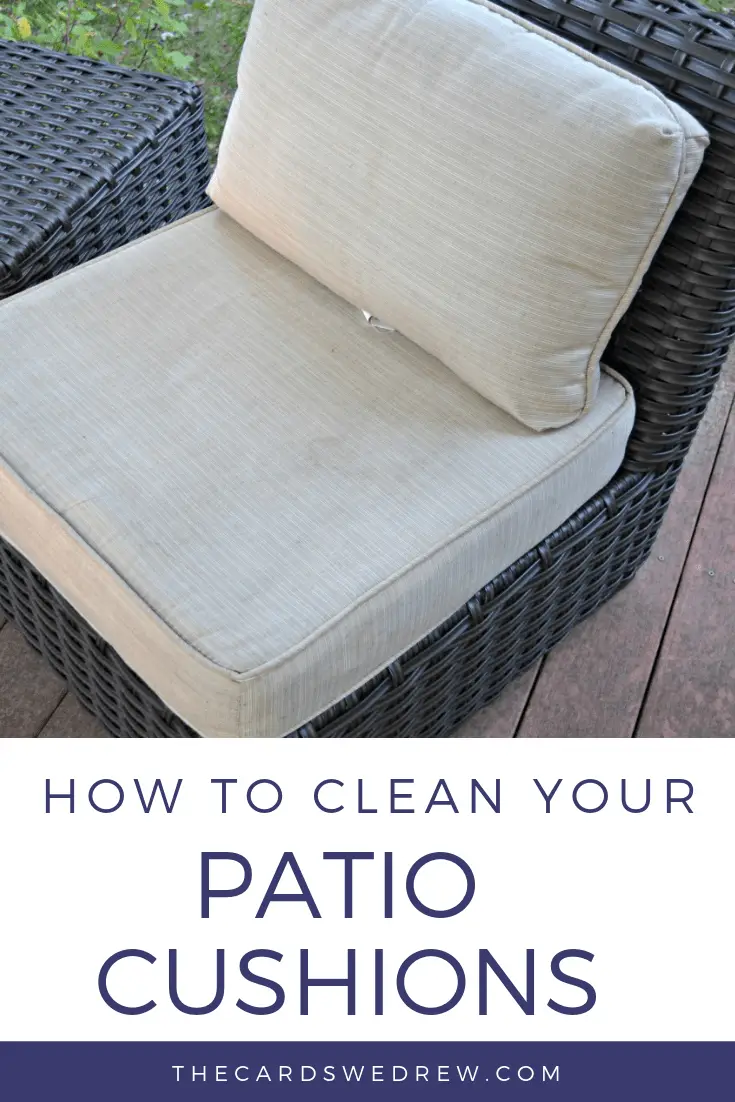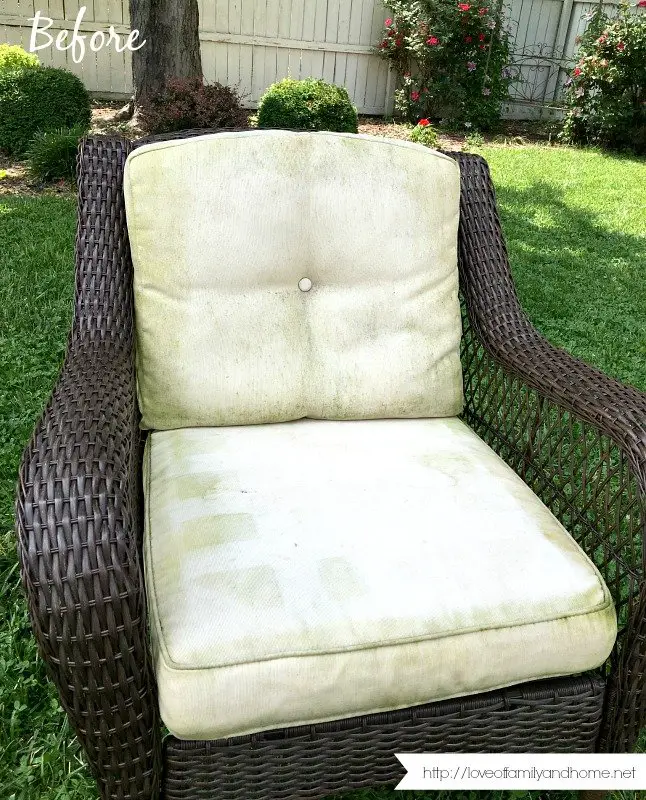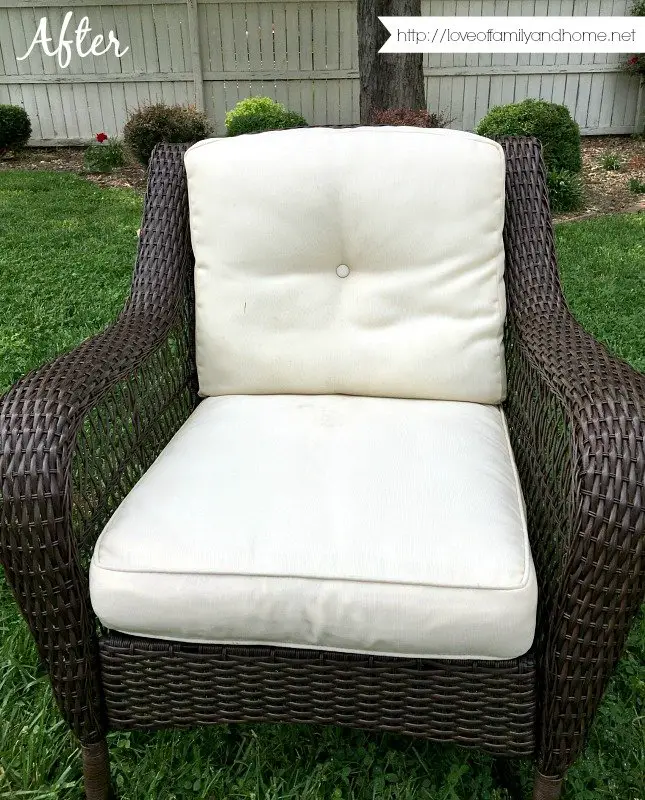Use What You Have Its Better For The Patio Furniture
Baking soda, bleach, borax, and Dawn Dishwashing soap are all inexpensive, and they are less abrasive than commercial brand cleaners as well.You want your patio to look fresh and inviting, but the patio furniture gets grimy just from sitting out in the wind and dust. People spill their drinks and drop their ice cream, but those outdoor furniture stains can be quickly cleaned for a brighter and more beautiful patio set.Whether you have chosen wicker, metal or resin outdoor furniture, or furniture with cloth cushions and an umbrella, it can be kept clean and new looking for a long time with the right care and patio furniture protection measures.
Soak The Cushion Before Washing
Good for: Mildew or mold
You might have thought about replacing your patio furniture cushions especially after noticing the mold buildup but wait, there are solutions. Your patio furniture cushions might become riddled with mildew or mold if left in wet or humid conditions. Beverage spills left untreated might also lead to mildew on and within the cushion. In this case, youll need a container, water hose, brush, and cleaning solution of dishwashing detergent, borax, and water to get this dirt out.
You can use a spray bottle to soak the cushions or create a large amount of mixture in a bucket to submerge your cushions. Leave the cushions for 15 minutes to an hour and then wash off the mixture and dirt with your garden hose. Instead of borax, you can add some bleach to thoroughly eliminate mold.
Another common dirt might be tree sap on your cushions. SFGate suggests applying detergent on the affected area and wait 30 minutes before wiping it off. Another suggestion is using an enzyme-based stain remover to break down the sap. Keep the solution on for at least 15 minutes. Alternatively, you can use an extra-strength detergent and a handheld brush to scrub away the sap. Wash off any leftover solution and sap with water.
How To Prevent Mildew On Outdoor Cushions
The best way to prevent mildew on outdoor cushions is to bring your cushions inside when theyre not in use.
If you forget and it rains, then move the cushions into a dry place with lots of ventilation so that they can quickly dry. Laundry racks are great for this. Flip them over every half hour to allow the entire cushion to dry.
If you live in a humid place or can never seem to remember to bring them in, invest in quality acrylic or olefin cushions. Yes, theyre not natural materials, but theyre more sustainable in the long run when you dont have to replace your cushions every season.
In the off-season, store outdoor cushions in a well-ventilated, low humidity place.
And clean the cushions regularly. When you clean regularly, you stop mildew from penetrating deeper into the cushion, and you can use more natural, less toxic methods. Regularly spray your cushions with white vinegar and give them a light scrub.
Read Also: Uv Light For Mold Killing
So What Can You Do To Clean Off Mould From Your Cushions
The best way to kill and effectively remove mould is to use bleach, which will destroy the mould organisms themselves and also clean the surfaces very thoroughly, in many cases removing any stains the mould may otherwise leave behind. Of course, using bleach on any fabric can cause some colour loss, so you need to dilute the bleach and also test out the solution you are using on a small, not very visible part of the fabric before you start scrubbing off the mould. For most vinyl or acrylic outdoor cushions, a reasonable solution to use is one cup of bleach in a litre of water, with around a cup of normal fabric detergent added in to make it easier to work with and to boost its cleaning power.
Remove Mildew From Wooden Outdoor Furniture

Mildew even grows on wooden outdoor furniture in hot, humid climates. You can use a mild bleach solution to remove mildew, but if you want to avoid that lingering bleach odor, white vinegar can also remove the mildew:
Also Check: How To Clean Mold Off Canvas
How Often To Clean
Don’t allow stains to wait for summer to end before you treat them. The type of stain remover you need depends upon the specific stain. A good overall cleaner is Carbona Pro Care Oxy Powered Outdoor Cleaner. The foaming action and built-in scrub brush is perfect for outdoor fabrics. The key to success is giving the treatment time to work. No product is magic allow it at least 30 minutes to penetrate to loosen the stains. While you are cleaning the cushions, don’t forget to give metal, plastic, and rattan furniture a proper cleaning.
The Spruce / Almar Creative
Launder as usual. Fabric stained with self-tanner will need additional treatment.
How To Get Rid Of Mildew In A Sofa Cushion
Sofa cushions, usually filled with a thick foam material, act like a sponge when they get wet. If the moisture isn’t promptly removed, fuzzy mold and mildew can develop. When left alone, mildew spores tunnel deep down into your sofa cushions, where it’s almost impossible to get them out. If a mildew stain is relatively new, though, there’s still hope. Disinfecting the fabric will knock out the spores and help get rid of any discoloration.
1
Take the sofa cushion outdoors, if possible, and brush off as much mildew as you can with a stiff-bristled broom. By doing this, you’ll avoid spreading mildew spores inside your home. If you can’t remove the cushion, vacuum the mildew-stained sofa with the machine’s nozzle attachment.
2
Combine 1 cup rubbing alcohol and 1 cup warm water, or 1 cup ammonia and 1 cup cool water. Dampen a cloth with the solution, then squeeze out excess liquid.
3
Sponge the mildew stain with the damp cloth a few times until the discoloration disappears.
4
Dampen a clean cloth with cool water, then blot the area to rinse off the rubbing alcohol and water or the ammonia and water mixture.
5
Lightly mist the fabric with a fungicide spray or disinfectant spray to kill any remaining mildew spores. Do not rinse off.
6
Let the cushion dry outside in the sun, or set it in front of a running fan. Holding up a hair dryer set on the “cool” temperature setting also works.
References
Also Check: How Many Parts Bleach To Water To Kill Mold
How Do You Remove Oxidation From Patio Furniture
Heres how to treat oxidized or rusted metal on outdoor furniture:
Baking Soda And Vinegar
Baking soda is an incredible choice for mold removal of clothes, curtains, cushions, etc. These home ingredients can remove mold infestation pretty well.
Create a paste of baking soda and vinegar. Then use a soft brush to use this baking soda paste on the moldy areas. Let the clothing sit for 15-20 minutes and wash it off.
Also Check: How To Get Rid Of Airborne Mold In House
Mold And Mildew Stains
Brush away as much of the mildew as possible using a nylon brush. Create a cleaning solution of 1 part Borox and 4 parts warm water. Generously apply the cleaning solution to the cushion fabric and use a microfiber cloth to blot out the stain. For tougher stains, allow the cleaning solution to sit for a longer period of time before blotting. Rinse thoroughly with clean water and dry completely.
If the Borox solution still doesnt completely work, something like Oxiclean or a 1:1 mixture of hydrogen peroxide and water will be a little stronger and usually does the trick. Alternatively, you can try a mild bleach solution of 1 tbsp. of bleach to a pint of warm water. Not all outdoor materials can handle bleach, however, so be sure to test for color fastness first and read all labels.
Determine How Heavily Soiled Your Cushions Are
Less is always more where it comes to cleaning outdoor furniture cushions. If yours only have a stain here and there, go easy on them. The less contact with the foam inner, the easier it will be to dry them and the less chance for permanent damage to the foam.
Nadeem Abbas, owner of Love2Laundry, says: make a solution of water and detergent in a spray bottle and apply to the cushions before scrubbing dirt away with a soft brush. Avoid oversaturating the cushions as this may damage the foam.
Also Check: How To Prevent Mold In Shower Grout
Removing Mildew From Wood
Many people think bleach is the answer for removing mildew, but bleach can be too harsh for your wooden outdoor furniture. It can weaken and discolor the wood, causing even more problems.
For wooden patio furniture mix a solution of 1 cup ammonia, 12 cup white vinegar, and 14 cup of baking soda into 1 gallon of water. Use a kitchen sponge or washcloth for application. If you notice any mildew growth coming back, use full-strength white vinegar immediately to nip it in the bud.
Getting Rid Of The Spores

In the case of machine-washable mold stains, you need to take care of the fungus spores at first. So, take the clothing outside, better if it is sunny.
Go ahead and brush off the excess spores off of the clothing item. Make sure to brush the fungus spores from both sides of the clothing.
A word of caution, these mold spores can cause an allergic reaction, so if you have asthma, I suggest you wear a mask while dusting this pesky powder off.
Don’t Miss: How To Treat Mold On Sheetrock
How To Use The Bleach Solution
Once you have mixed and tested your bleach solution, you are ready to begin fighting that mould. Apply the solution to the fabric and use a brush to gently but firmly scrub the mould out of the fabric. It may take some time, but once your solution has killed and cleaned off the mould, you need to rinse the surface with water to remove any residual bleach that could deteriorate the fabric, and also deplete that bleach smell somewhat. Leave the fabric to dry, preferably in sunlight, and your cushions should be mould free.
Of course, the best thing is to avoid mould growth altogether, so try and ensure your cushions are made from the right sort of fabric for outdoors, and that they are in a place where they get plenty of sunlight to help them dry out when any moisture occurs.
As the unofficial Cushion Experts, Cushion Factory would love to help you create a space that you and your guests cant wait to relax in. Say goodbye to those old faded cushions or that bare space.
If you would like to see what we have created for other clients around Australia, click here to go our Client Photo gallery. Have a question? Dont hesitate to email us at or phone us at 1300 448 297.
We would love to hear about your next decorating project!
Mildew And Outdoor Cushions
Mildew spores are everywhere because they are airborne. This means that almost all household surfaces are vulnerable to mildew growth.
However, mildew does not just grow out of the blue. It needs four conditions before settling on a surface.
First, it needs a food source. Dirt, dust, and other organic materials can be food sources for mildew.
Second, it needs air. Mildew and mold cannot exist in tightly-sealed spaces because of the lack of air.
Although, you cannot seal your house entirely as you need air to breathe. This makes it easy for mildew to grow in your household.
Third, mildew needs a specific temperature to grow. It cannot exist in places where the temperature is too hot or too cold.
Most households have a standard temperature because its necessary for us too. Hence, this condition is not hard to cross off the list, too.
Lastly, mildew needs moisture to grow. This is why mildew and mold are often water-damaged products in the household.
Water damage is a serious issue because it leads to mildew and mold growth and because it can weaken your home. Hence, the best way to prevent mildew growth on any part of your home is to protect it from water damage.
Outdoor cushions can still be vulnerable to mildew growth. When it rains, they can get wet and house mildew.
Mildew only takes a maximum of two days to grow on wet fabric. If you leave them for weeks, it may get to the point that even vinegar cannot remove the mildew growth.
Read Also: How To Clean Mold Off Plastic Cutting Board
How To Clean Patio Cushions In Canvas With Lysol
If you prefer cleaning outdoor furniture mildew from canvas with a less harsh approach, the following method may be just what youre looking for:
Should I Use Bleach To Clean Up Mold
The EPA recommends against using bleach to clean up mold, with the caveat that professional cleanup crews may use their judgment on a case-by-case basis. Sterilizing the affected area with bleach isnt that effective when there are mold spores in the air. If thats all thats done, then the spores will land and start growing again. Fixing the root problem will keep mold from sprouting in the first place.
Bleach also causes another problem for outdoor cushions most materials will fade in color and bleach can destroy foam.
Try the vinegar method first before reaching for bleach. Check the label to see if its bleach safe and dilute it! Use only ½ cup of bleach in 1 gallon of water.
And if the mold problem is so pervasive through cushions that you cant clean it through other methods, then it may be better to replace the items.
Recommended Reading: How Quickly Can Mold Grow
How Does Mold Start To Grow
The beginnings of mold growth are spores that are carried by the wind and spread by the billions in the air, looking for a place with the right conditions to grow. So what are the right conditions?
Molds need four elements in order to develop:
How Do You Remove Mildew From Metal Outdoor Furniture
Metal furniture can be prone to mold building up in the form of algae or mildew. To remove mold from metal outdoor furniture, you want to make sure to have the proper tools, including:
- Face mask
- Spray bottle
- Cloth
After gathering your materials, proceed to inspect the furniture from top to bottom so you know where the mold is located. Any untreated mold will continue to spread, so be sure to look under the furniture and in every hidden nook. Once inspected, follow these steps:
Don’t Miss: How To Mold Leather Holster
How To Clean Oil
Whether its from sunscreen, bug spray, or food, oils can make their way onto outdoor cushions and pillows. These oils can also attract more dirt and grime. Dont worry, though! You can remove these stains with a dry absorbent powder like cornstarch or baking soda. Follow these steps to tidy up your cushions.
How To Remove Stains From Canvas Patio Furniture And Pillows

- Mildew: While the fabric is dry, brush the surface with a soft-bristled brush to loosen and remove mildew spores. Make a paste of one tablespoon liquid laundry detergent and one teaspoon powdered oxygen bleach and apply it to the mildew stains with a soft-bristled brush. Allow the paste to sit for at least one hour before rinsing.
- Food and oily stains: Use a dab of heavy-duty laundry detergent on each stained area and work it into the fabric with a soft-bristled brush. Let it sit for at least 15 minutes before rinsing.
- Bird droppings: If the dropping is wet, allow it to dry before cleaning. Use the edge of a dull knife or a credit card to lift away any dry solids. Dab the spot with liquid detergent, work it into the stain with a brush, and let it sit for 15 minutes. Add a bit of powdered oxygen bleach to the detergent if the stain is dark from berries the bird ate.
- Grass: Make a paste of one tablespoon liquid laundry detergent and one teaspoon powdered oxygen bleach and apply it to the stain with a soft-bristled brush. Allow the paste to sit for at least 30 minutes before rinsing.
- Tree sap: Work a dab of heavy-duty laundry detergent onto the stained area with a scrub brush. Let it sit for 15 minutes before scrubbing the area with the brush dipped in hot water.
You May Like: Clean Mold Off Boat Seats
